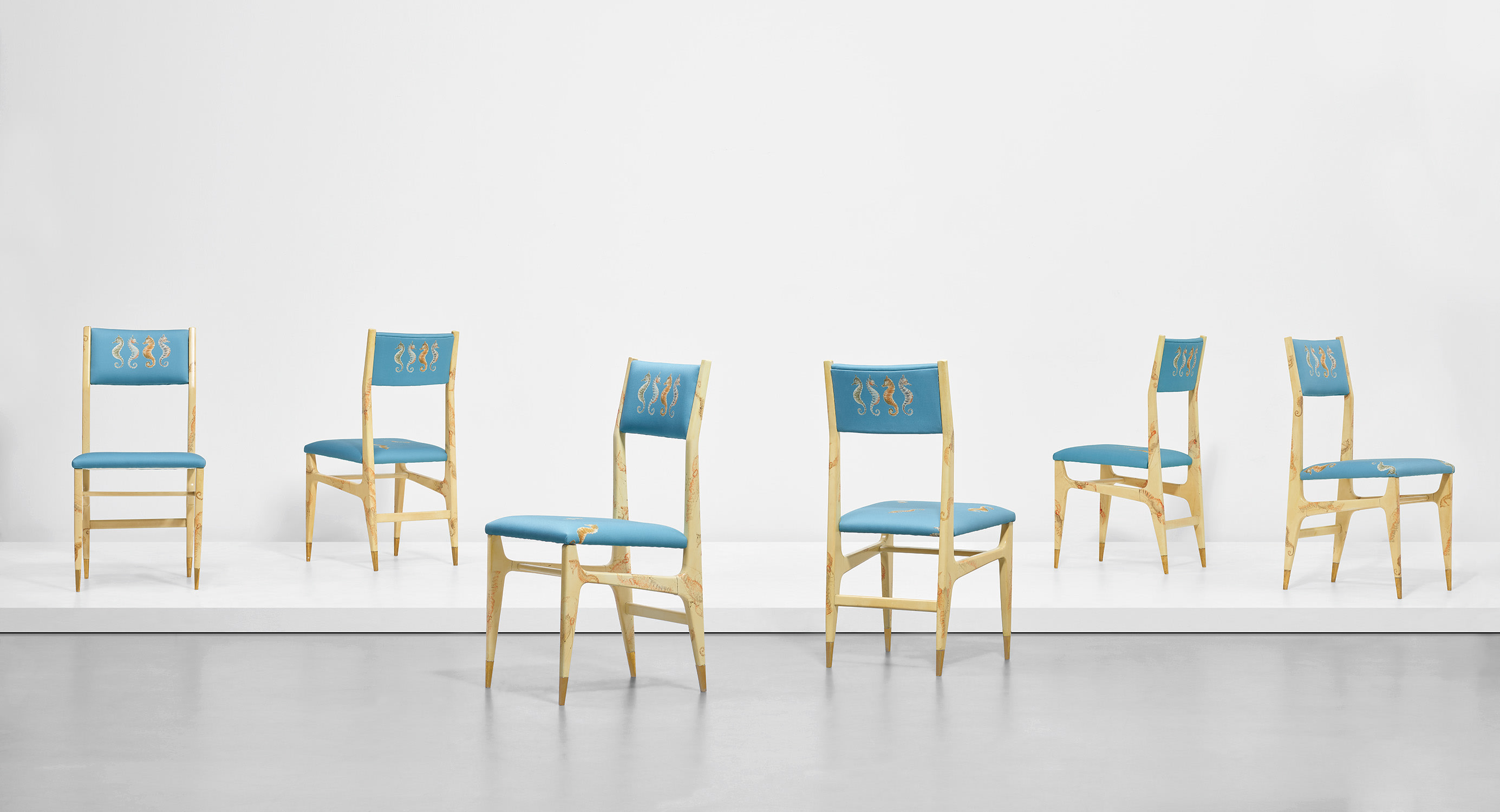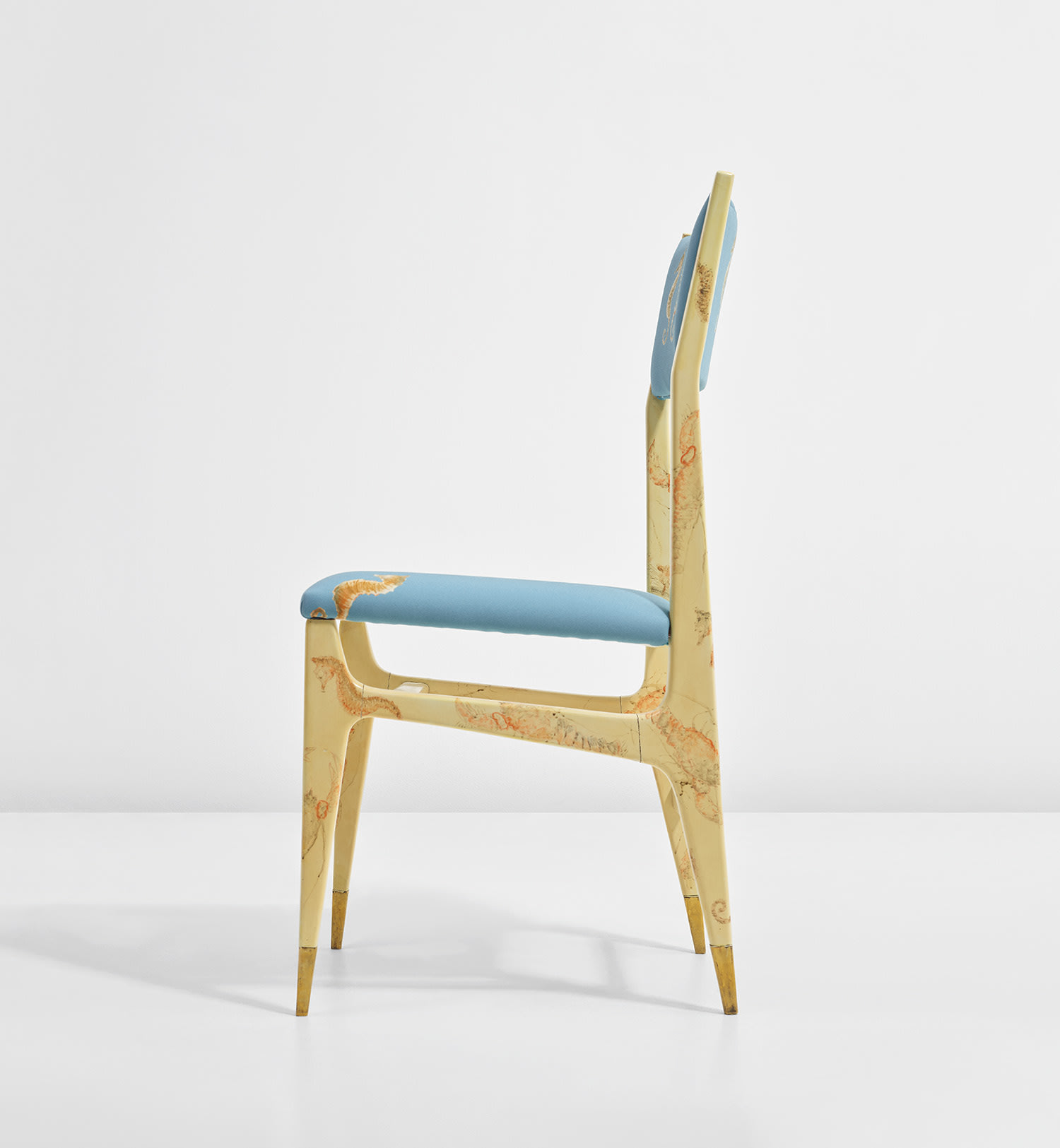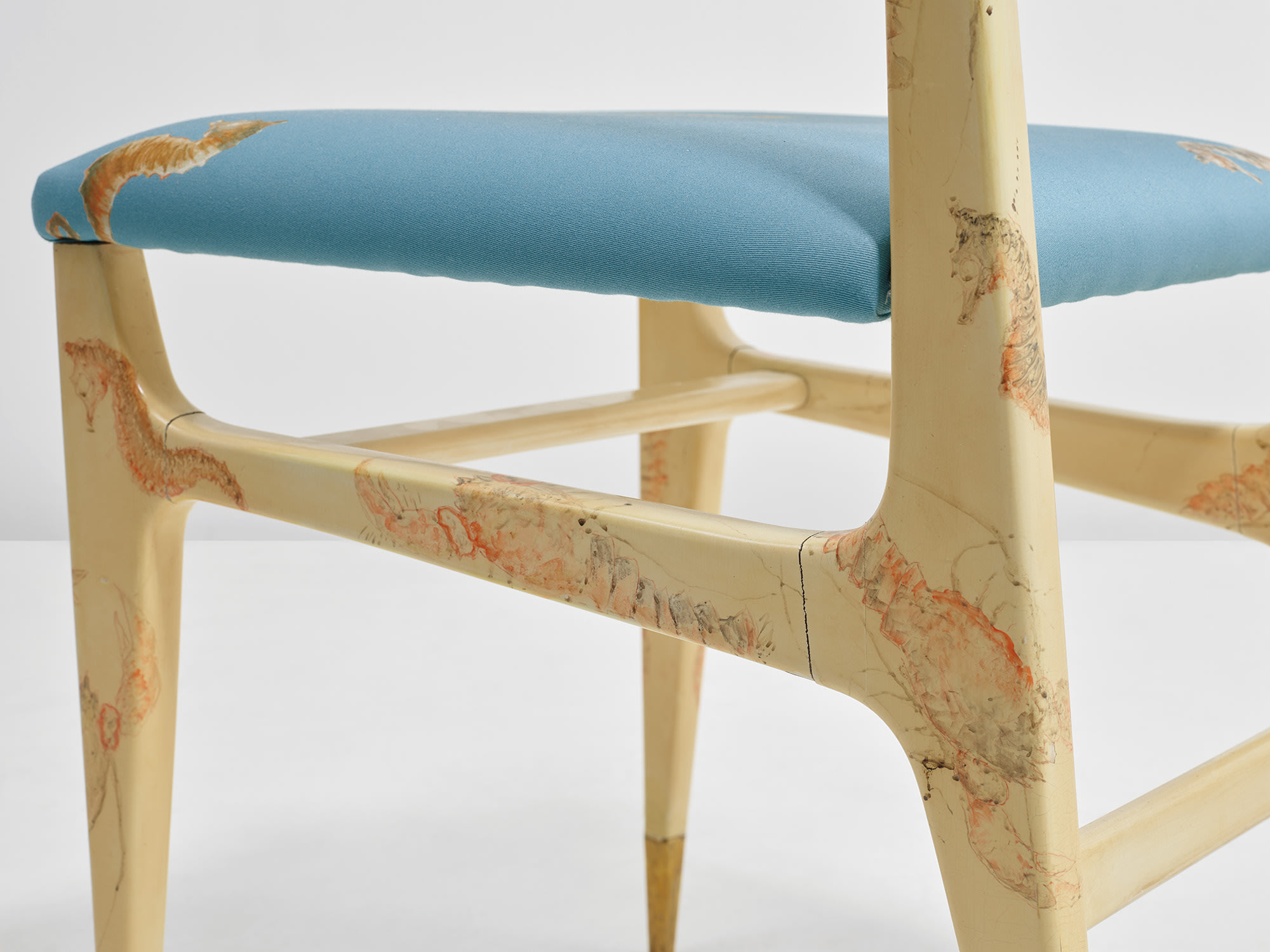







16
Gio Ponti and Piero Fornasetti
Set of six prototype dining chairs
early 1950s
Painted wood, fabric, brass.
Tallest: 93.5 x 46.5 x 50.5 cm (36 3/4 x 18 1/4 x 19 7/8 in.)
Executed by Giordano Chiesa, Milan, Italy. Together with a certificate of expertise from the Gio Ponti Archives.
Full-Cataloguing
Ponti & Fornasetti - The Magic of Nature and History in the Dining Room
By Brian Kish
Curator and Specialist in 20th Century Italian architecture and design. Associate member of the Gio Ponti Archives since 2006.
This prototype table and six chairs were created for a seminal exhibition ‘Italy At Work: Her Renaissance in Design Today’, an exceptional commission for which Gio Ponti was autonomous from a specific client and thus provided with a small stage for upbeat innovations in the post-war gloom.
Opening at The Brooklyn Museum in 1950 the exhibition ‘Italy at Work’ travelled to eleven other cities across the US and became critical in disseminating Italian design culture, while unleashing lucrative business opportunities for the architects and artisans involved. Ponti’s dining room was a delirium of Metaphysical and Surrealist tropes, amplified by Piero Fornasetti's surface patterning.
What is at first striking is the imagery, hand-painted by Fornasetti himself, of seahorses (hippocampi) in movement. That most enigmatic animal in nature and mythology becomes the prominent motif chosen for the table and repeated on the chair upholstery. Then, as a counterpoint he introduces the lobsters with their distinct shape and agility: nimble seahorses vs almost immobile lobsters.
These forms turn out to complement each other to perfection. The curved claws of the lobsters, exedra like, are visually linked to the voluted spiralling tails of the seahorses. These volutes positioned in alignment on the chair upholstery bring in a sapient hint at Rococo decorative friezes. With Ponti and Fornasetti an intentional push and pull condition is at work, whereby the subtle tectonics of Ponti's table and chairs are obliterated by the painted surfaces of Fornasetti. Form and image play an acrobatic performance to achieve a surprising synthesis.
Ponti’s table and chairs were executed by Giordano Chiesa and hand-painted by Fornasetti and two sets were made, in both larger and smaller dining table scales. Along with four chairs the smaller table was sent along on its American museum journey, its whereabouts still unknown at this time. The larger version with six chairs remained in Milan, and is now here at its first public debut. A secondary variant, was made with Fornasetti’s transfer-printed madrepores (coral branches) on a turquoise coloured ground, where it was commercially marketed at various American venues, which coincided with the US museum exhibition of Italian design. It too was produced limited quantities by Fornasetti’s Milan workshop, along with other iterations, and all on custom order.
The concave table top, covered over in tempered crystal, allows an optical reading of a virtual pool or basin containing marine life, alluding to sea mysteries. Ponti’s concept of a comparable concave glass topped table is found in his mid-1930s coffee table sketches for Fontana Arte. He revised this earlier idea for the prototype early 1950s dining table. (Since then, a similar design became renowned through adaptations by Max Ingrand such as his famous blue crystal ‘lens’ coffee table, Fontana Arte model #1774.)
It is in Fornasetti’s own words that this work finds another point of view: ‘The public explained to me that what I did was something more than decoration. It was an invitation to the imagination, to think, to escape from those things around us that are too mechanised and inhuman. They were tickets to travel through the realm of the imagination’. (Patrick Mauriès, Piero Fornasetti: Practical Madness, London, 2015, p.137)
For the ancient Etruscans the seahorse was a creature that was believed to transport one into another world, and so for Ponti and Fornasetti these symbols, un-arbitrarily selected, denote a conduit to ancient Mediterranean cultures. As a source that anchored their modern sensibilities towards reflective reasonings, it became an embodiment of sensual intelligence with a capacity for critical distance that ends up delivering something enticing, equivocal, and enchanting.
By Brian Kish
Curator and Specialist in 20th Century Italian architecture and design. Associate member of the Gio Ponti Archives since 2006.
This prototype table and six chairs were created for a seminal exhibition ‘Italy At Work: Her Renaissance in Design Today’, an exceptional commission for which Gio Ponti was autonomous from a specific client and thus provided with a small stage for upbeat innovations in the post-war gloom.
Opening at The Brooklyn Museum in 1950 the exhibition ‘Italy at Work’ travelled to eleven other cities across the US and became critical in disseminating Italian design culture, while unleashing lucrative business opportunities for the architects and artisans involved. Ponti’s dining room was a delirium of Metaphysical and Surrealist tropes, amplified by Piero Fornasetti's surface patterning.
What is at first striking is the imagery, hand-painted by Fornasetti himself, of seahorses (hippocampi) in movement. That most enigmatic animal in nature and mythology becomes the prominent motif chosen for the table and repeated on the chair upholstery. Then, as a counterpoint he introduces the lobsters with their distinct shape and agility: nimble seahorses vs almost immobile lobsters.
These forms turn out to complement each other to perfection. The curved claws of the lobsters, exedra like, are visually linked to the voluted spiralling tails of the seahorses. These volutes positioned in alignment on the chair upholstery bring in a sapient hint at Rococo decorative friezes. With Ponti and Fornasetti an intentional push and pull condition is at work, whereby the subtle tectonics of Ponti's table and chairs are obliterated by the painted surfaces of Fornasetti. Form and image play an acrobatic performance to achieve a surprising synthesis.
Ponti’s table and chairs were executed by Giordano Chiesa and hand-painted by Fornasetti and two sets were made, in both larger and smaller dining table scales. Along with four chairs the smaller table was sent along on its American museum journey, its whereabouts still unknown at this time. The larger version with six chairs remained in Milan, and is now here at its first public debut. A secondary variant, was made with Fornasetti’s transfer-printed madrepores (coral branches) on a turquoise coloured ground, where it was commercially marketed at various American venues, which coincided with the US museum exhibition of Italian design. It too was produced limited quantities by Fornasetti’s Milan workshop, along with other iterations, and all on custom order.
The concave table top, covered over in tempered crystal, allows an optical reading of a virtual pool or basin containing marine life, alluding to sea mysteries. Ponti’s concept of a comparable concave glass topped table is found in his mid-1930s coffee table sketches for Fontana Arte. He revised this earlier idea for the prototype early 1950s dining table. (Since then, a similar design became renowned through adaptations by Max Ingrand such as his famous blue crystal ‘lens’ coffee table, Fontana Arte model #1774.)
It is in Fornasetti’s own words that this work finds another point of view: ‘The public explained to me that what I did was something more than decoration. It was an invitation to the imagination, to think, to escape from those things around us that are too mechanised and inhuman. They were tickets to travel through the realm of the imagination’. (Patrick Mauriès, Piero Fornasetti: Practical Madness, London, 2015, p.137)
For the ancient Etruscans the seahorse was a creature that was believed to transport one into another world, and so for Ponti and Fornasetti these symbols, un-arbitrarily selected, denote a conduit to ancient Mediterranean cultures. As a source that anchored their modern sensibilities towards reflective reasonings, it became an embodiment of sensual intelligence with a capacity for critical distance that ends up delivering something enticing, equivocal, and enchanting.